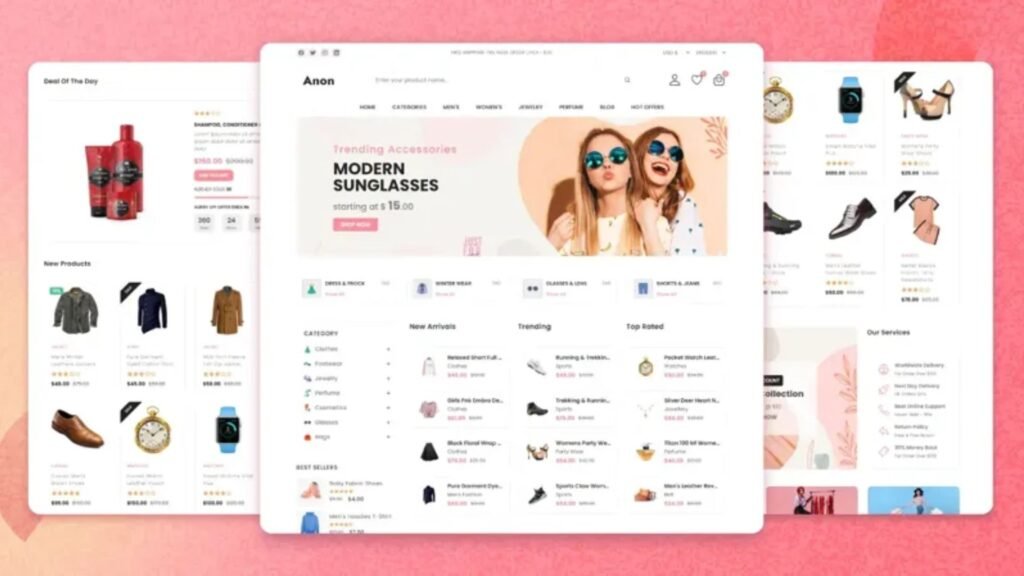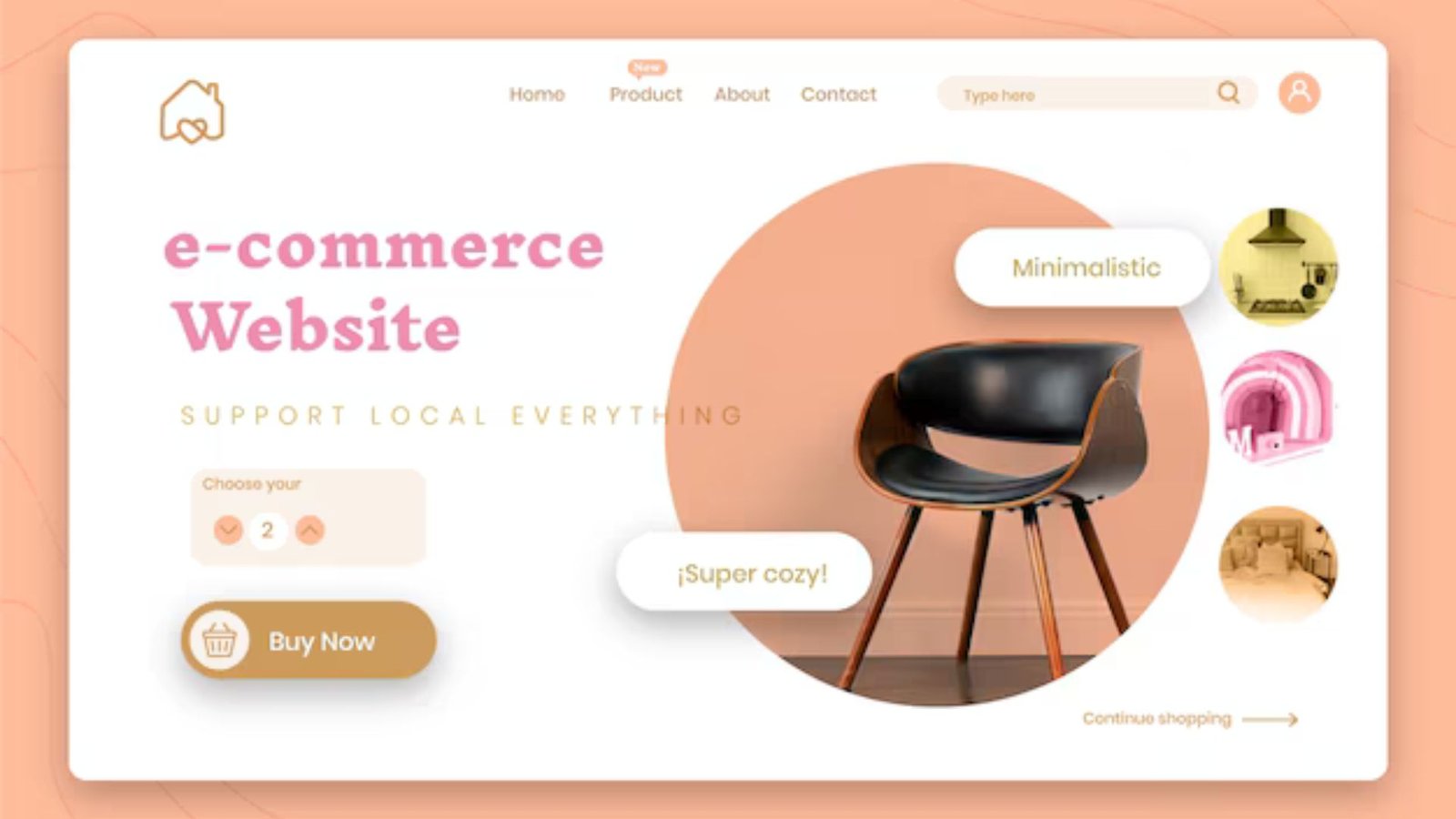How to Design for E-commerce Sites
- By -Daisy
- Posted on
- Posted in Web Designing
Designing an e-commerce site goes beyond creating an attractive layout. The goal is to craft a user-friendly, efficient, and visually appealing shopping experience that not only showcases products but also drives conversions. Whether you’re designing an online store for a small business or a large-scale retailer, a great e-commerce design can make all the difference in customer engagement and sales. In this guide, we will walk you through essential tips and best practices for designing a high-performing e-commerce website.

User-Friendly Navigation
Navigation is one of the most critical aspects of e-commerce design. Users need to easily find what they’re looking for, whether it’s a specific product or information about your company. A clear, simple navigation structure can significantly improve user experience (UX) and reduce bounce rates.
Key Tips:
- Simple Main Menu: Keep the main menu minimal with categories such as Home, Shop, About, Blog, and Contact. Include subcategories under product categories to help users filter items more easily.
- Sticky Navigation: A sticky header with a search bar and cart icon ensures that users can quickly access important functions no matter where they are on the page.
- Breadcrumbs: Breadcrumb navigation is an essential tool for guiding users back to previous pages. It helps with site exploration and gives users a sense of their location within the site.
Clear Call-to-Action (CTA) Buttons
Your CTAs are what guide users through their purchasing journey. From “Add to Cart” to “Proceed to Checkout,” these buttons need to be highly visible and clear.
Key Tips:
- Color Contrast: Make sure your CTA buttons stand out by using contrasting colors that draw attention without clashing with the rest of your website’s design.
- Text Clarity: Use simple and direct language for your CTAs, like “Buy Now” or “Add to Cart.” Avoid using ambiguous phrases.
- Placement: Place CTAs above the fold on product pages and throughout the shopping process to encourage users to take action immediately.
Explore Online Entertainment
While xenexbd.com focuses on its specific content, we understand that our visitors may have diverse interests. If you’re looking for online entertainment beyond our offerings, you might find engaging opportunities on different platforms. For those interested in exploring online gaming, consider looking into australian casino online, where a variety of games and potential experiences are available. We encourage responsible exploration of online activities that align with your interests.
Responsive and Mobile-Friendly Design
With mobile commerce on the rise, having a mobile-friendly design is a must. E-commerce sites need to function seamlessly across devices of all sizes. A responsive design ensures that your site automatically adapts to any screen size, providing an optimal shopping experience for all users.
Key Tips:
- Responsive Layout: Use flexible grid layouts, fluid images, and scalable fonts so that your site adjusts smoothly to different screen sizes.
- Simplified Checkout: Mobile users should be able to complete their purchases quickly. Minimize the number of steps needed to check out and offer mobile-optimized payment options.
- Touch-Friendly UI: Ensure buttons and links are large enough to be tapped easily on smaller screens, and simplify navigation for mobile users.
Innovative Tech Meets Entertainment
XenexBD is at the forefront of technological solutions, offering innovative tools that simplify and enhance digital experiences. For those looking to mix technology with interactive fun, kingjohnnie.io/ provides an engaging platform full of exciting online games. Both platforms prioritize user experience and innovation, making every interaction meaningful and enjoyable. Explore the possibilities and elevate your digital engagement today.
Effective Product Pages
Your product pages are the heart of your e-commerce site. A good product page provides all the necessary information and encourages customers to make a purchase. Think of it as a virtual salesperson that needs to convey trust, information, and excitement.
Key Tips:
- High-Quality Images: Use high-quality, well-lit images that show the product from multiple angles. Zoom-in functionality helps customers get a closer look at the details.
- Detailed Descriptions: Include clear, concise product descriptions that highlight key features and benefits. Focus on addressing potential customer pain points or common questions.
- Price and Availability: Ensure the price, availability, and shipping details are clearly displayed and easy to find. Show customers the total price with taxes and shipping included upfront.
- Product Reviews: Display customer reviews and ratings to build trust. Positive reviews can influence purchasing decisions and provide valuable social proof.
Streamlined Checkout Process
A complicated checkout process can lead to cart abandonment. The simpler and more straightforward the checkout experience, the more likely customers are to complete their purchase. Optimizing this process is crucial for improving conversion rates.
Key Tips:
- Guest Checkout Option: Allow users to checkout as guests without requiring account creation. While accounts are beneficial for return customers, forcing users to register can discourage them from completing a purchase.
- Progress Indicators: Use progress bars to indicate where the user is in the checkout process. This helps set expectations and reduces anxiety about long forms.
- Multiple Payment Methods: Offer various payment options such as credit cards, PayPal, Apple Pay, or even buy-now-pay-later services, depending on your target audience.
Trust Signals
Trust is crucial for e-commerce success. Customers need to feel confident that their personal and payment information is safe and that they are dealing with a reputable company.
Key Tips:
- SSL Certificate: Ensure your site is secured with SSL encryption, showing users that their data is protected.
- Customer Service Information: Display clear contact information, including phone numbers, email addresses, and links to live chat or FAQs.
- Money-Back Guarantee: Offering a return policy or a satisfaction guarantee gives customers confidence that they can make a purchase without risk.
- Trust Badges: Add recognizable security badges (such as SSL or payment provider logos) to reassure customers about the safety of their transactions.
Reliable Tech Solutions from Xenex BD
Xenexbd.com specializes in providing advanced technology services and solutions tailored to meet business needs. Their expertise ensures seamless integration and innovative approaches to enhance operational efficiency. Committed to quality and customer satisfaction, Xenex BD supports growth through smart tech. For a fun and secure way to unwind, explore a trusted french online casino offering top-notch gaming experiences.
Innovative Solutions and Engaging Online Experiences
XenexBD provides technology solutions and services designed to enhance business efficiency and digital presence. For moments of interactive enjoyment, the jokacasino Login offers engaging online games and entertainment. Combining innovative tech solutions with digital fun keeps users both productive and entertained.
Discover Live Casino Entertainment
Xenexbd.com shares a variety of interesting articles and updates. For fun and excitement, try live dealer casino games for real-time interactive gameplay. Experience thrilling casino action without leaving home. Add entertainment to your daily routine effortlessly.
Conclusion
Designing for e-commerce is all about creating a seamless, intuitive experience that encourages users to explore, engage, and ultimately purchase products. By focusing on user-friendly navigation, clear product pages, optimized checkout processes, and a visually appealing layout, you can design an e-commerce site that not only attracts customers but also converts them into loyal buyers. Whether you’re just starting out or looking to improve an existing online store, following these design principles will help you create an effective e-commerce platform that supports your business goals and enhances the customer experience.



